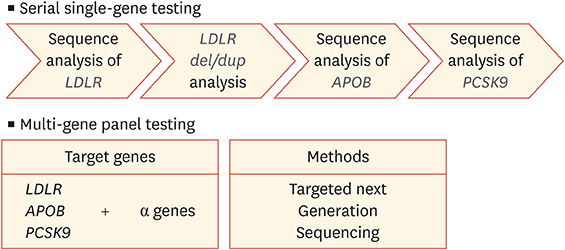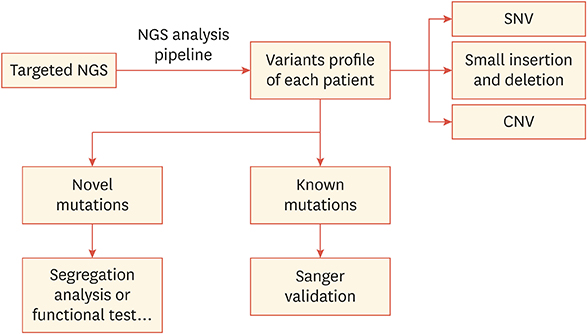J Lipid Atheroscler.
2018 Dec;7(2):122-154. 10.12997/jla.2018.7.2.122.
Screening, Diagnosis, and Treatment of Familial Hypercholesterolemia: Symposium of the Education Committee, Korean Society of Lipid and Atherosclerosis
- Affiliations
-
- 1Department of Health Promotion, Yonsei University College of Medicine, Seoul, Korea.
- 2Department of Clinical Pharmacology and Therapeutics, Kyung Hee University College of Medicine, Seoul, Korea.
- 3Division of Cardiology, Department of Internal Medicine, Kangnam Sacred Heart Hospital, Hallym University College of Medicine, Seoul, Korea.
- 4Department of Pediatrics, Inje University Sanggye Paik Hospital, Seoul, Korea.
- 5Department of Internal Medicine and Cardiovascular Center, Seoul National University Hospital, Seoul, Korea.
- 6Division of Cardiology, Department of Internal Medicine, Severance Hospital, Yonsei University College of Medicine, Seoul, Korea. shl1106@yuhs.ac
- 7Department of Internal Medicine, Seoul National University College of Medicine, Seoul, Korea.
- 8Department of Molecular Medicine and Biopharmaceutical Sciences, Graduate School of Convergence Science and Technology, Seoul National University, Seoul, Korea.
- KMID: 2429832
- DOI: http://doi.org/10.12997/jla.2018.7.2.122
Abstract
- Familial hypercholesterolemia (FH) is typically associated with single gene mutation that is inherited by autosomal dominant manner. Due to high cardiovascular risk, aggressive discovery, diagnosis, and treatment of FH are critical. Although FH is being increasingly spotlighted, we do not have sufficient data on Korean patients with FH. Here, we present the content of symposium of the Education Committee, Korean Society of Lipid and Atherosclerosis held in May 2018: 1) epidemiology, clinical diagnosis, Korean FH data, and regulation in Korea; 2) genes associated with FH, sequencing process in suspicious proband, cascade screening, and difficulty in genetic diagnosis in FH; 3) the importance of lipid-lowering therapy in FH, conventional and novel therapeutics for FH; 4) diagnosis of FH in children and adolescence, screening, and treatment of FH in children and adolescence; 5) history of FH studies in Korea, the structure and current status of FH registry of Korean Society of Lipid and Atherosclerosis; and 6) difficulty in diagnosis of heterozygous and homozygous FH, drug intolerance and achievement of treatment target. Discussion between speakers and panels were also added. We hope that this article is helpful for understanding FH and future studies performed in Korea.
Keyword
MeSH Terms
Figure
Cited by 1 articles
-
Role of Genetics in Preventive Cardiology: Focused on Dyslipidemia
Sang-Hak Lee
Korean Circ J. 2021;51(11):899-907. doi: 10.4070/kcj.2021.0239.
Reference
-
1. Austin MA, Hutter CM, Zimmern RL, Humphries SE. Genetic causes of monogenic heterozygous familial hypercholesterolemia: a HuGE prevalence review. Am J Epidemiol. 2004; 160:407–420.
Article2. Hovingh GK, Davidson MH, Kastelein JJ, O'Connor AM. Diagnosis and treatment of familial hypercholesterolaemia. Eur Heart J. 2013; 34:962–971.
Article3. de Ferranti SD, Rodday AM, Mendelson MM, Wong JB, Leslie LK, Sheldrick RC. Prevalence of familial hypercholesterolemia in the 1999 to 2012 United States National Health and Nutrition Examination Surveys (NHANES). Circulation. 2016; 133:1067–1072.
Article4. Shin DG, Han SM, Kim DI, Rhee MY, Lee BK, Ahn YK, et al. Clinical features of familial hypercholesterolemia in Korea: predictors of pathogenic mutations and coronary artery disease - a study supported by the Korean Society of Lipidology and Atherosclerosis. Atherosclerosis. 2015; 243:53–58.
Article5. Han SM, Hwang B, Park TG, Kim DI, Rhee MY, Lee BK, et al. Genetic testing of Korean familial hypercholesterolemia using whole-exome sequencing. PLoS One. 2015; 10:e0126706.
Article6. Richards S, Aziz N, Bale S, Bick D, Das S, Gastier-Foster J, et al. Standards and guidelines for the interpretation of sequence variants: a joint consensus recommendation of the American College of Medical Genetics and Genomics and the Association for Molecular Pathology. Genet Med. 2015; 17:405–424.
Article7. Nordestgaard BG, Chapman MJ, Humphries SE, Ginsberg HN, Masana L, Descamps OS, et al. Familial hypercholesterolaemia is underdiagnosed and undertreated in the general population: guidance for clinicians to prevent coronary heart disease: consensus statement of the European Atherosclerosis Society. Eur Heart J. 2013; 34:3478–3490.
Article8. Raal FJ, Pilcher GJ, Panz VR, van Deventer HE, Brice BC, Blom DJ, et al. Reduction in mortality in subjects with homozygous familial hypercholesterolemia associated with advances in lipid-lowering therapy. Circulation. 2011; 124:2202–2207.
Article9. Thompson GR, Blom DJ, Marais AD, Seed M, Pilcher GJ, Raal FJ. Survival in homozygous familial hypercholesterolaemia is determined by the on-treatment level of serum cholesterol. Eur Heart J. 2018; 39:1162–1168.
Article10. Oh J, Lee CJ, Kim DI, Rhee MY, Lee BK, Ahn Y, et al. Target achievement with maximal statin-based lipid-lowering therapy in Korean patients with familial hypercholesterolemia: a study supported by the Korean Society of Lipid and Atherosclerosis. Clin Cardiol. 2017; 40:1291–1296.
Article11. Raal FJ, Honarpour N, Blom DJ, Hovingh GK, Xu F, Scott R, et al. Inhibition of PCSK9 with evolocumab in homozygous familial hypercholesterolaemia (TESLA Part B): a randomised, double-blind, placebo-controlled trial. Lancet. 2015; 385:341–350.
Article12. Stein EA, Gipe D, Bergeron J, Gaudet D, Weiss R, Dufour R, et al. Effect of a monoclonal antibody to PCSK9, REGN727/SAR236553, to reduce low-density lipoprotein cholesterol in patients with heterozygous familial hypercholesterolaemia on stable statin dose with or without ezetimibe therapy: a phase 2 randomised controlled trial. Lancet. 2012; 380:29–36.
Article13. Raal F, Scott R, Somaratne R, Bridges I, Li G, Wasserman SM, et al. Low-density lipoprotein cholesterol-lowering effects of AMG 145, a monoclonal antibody to proprotein convertase subtilisin/kexin type 9 serine protease in patients with heterozygous familial hypercholesterolemia: the Reduction of LDL-C with PCSK9 Inhibition in Heterozygous Familial Hypercholesterolemia Disorder (RUTHERFORD) randomized trial. Circulation. 2012; 126:2408–2417.
Article14. Wiegman A, Gidding SS, Watts GF, Chapman MJ, Ginsberg HN, Cuchel M, et al. Familial hypercholesterolaemia in children and adolescents: gaining decades of life by optimizing detection and treatment. Eur Heart J. 2015; 36:2425–2437.
Article15. Stock J. Landmark position paper on paediatric familial hypercholesterolaemia from the EAS Consensus Panel. Atherosclerosis. 2015; 242:277–280.
Article16. Daniels SR, Gidding SS, de Ferranti SD. National Lipid Association Expert Panel on Familial Hypercholesterolemia. Pediatric aspects of familial hypercholesterolemias: recommendations from the National Lipid Association Expert Panel on Familial Hypercholesterolemia. J Clin Lipidol. 2011; 5:S30–S37.
Article
- Full Text Links
- Actions
-
Cited
- CITED
-
- Close
- Share
- Similar articles
-
- Individualized Treatment for Patients With Familial Hypercholesterolemia
- Penetrating Atherosclerotic Ulcer of the Descending Thoracic Aorta in a Patient with Heterozygote Familial Hypercholesterolemia
- 2022 Consensus Statement on the Management of Familial Hypercholesterolemia in Korea
- Limitations of current screening methods for lipid disorders in Korean adolescents and a proposal for an effective detection method: a nationwide, cross-sectional study
- Characteristics of Acute Cerebral Infarction in Patients with Familial Hypercholesterolemia





